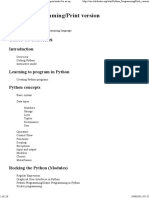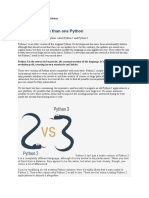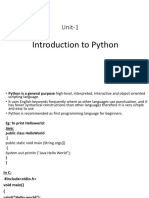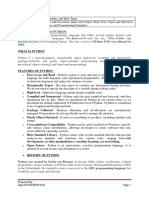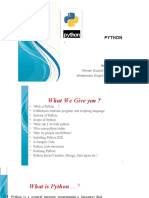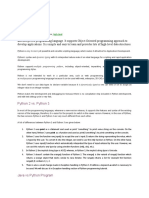0 ratings0% found this document useful (0 votes)
36 viewsIntro To Python
Uploaded by
SahilCopyright
© © All Rights Reserved
We take content rights seriously. If you suspect this is your content, claim it here.
Available Formats
Download as DOCX, PDF, TXT or read online on Scribd
0 ratings0% found this document useful (0 votes)
36 viewsIntro To Python
Uploaded by
SahilCopyright
© © All Rights Reserved
We take content rights seriously. If you suspect this is your content, claim it here.
Available Formats
Download as DOCX, PDF, TXT or read online on Scribd
You are on page 1/ 2
What is Python?
Python is a widely used high-level programming language for
general-purpose programming, created by Guido van Rossum and
first released in 1991. Python features a dynamic type system and
automatic memory management and supports multiple
programming paradigms, including object-oriented, imperative,
functional programming,
and procedural styles. It has a large and comprehensive standard
library.
Two major versions of Python are currently in active use:
Python 3.x is the current version and is under active development.
Python 2.x is the legacy version and received only security
updates until 2020. No new features will be
implemented. Note that many projects still use Python 2, although
migrating to Python 3 is getting easier.
Verify if Python is installed
To confirm that Python was installed correctly, you can verify that
by running the following command in your favorite terminal.
$ python --version
Python 3.x Version ≥ 3.0
Note:
If you are using Windows OS, you need to add path of python
to the environment variable before using it in command prompt
If you have Python 3 installed, and it is your default version you
should see
something like this:
$ python --version
Python 3.6.0
Python 2.x Version ≤ 2.7
If you have Python 2 installed, and it is your default version you
should see
something like this:
$ python --version
Python 2.7.13
You can use the Python 3 print function in Python 2 with the
following import statement:
from __future__ import print_function
If you want to run Python 3 from your terminal, execute the
command python3.
$ python3
Python 3.6.0 (default, Jan 13 2017, 00:00:00)
[GCC 6.1.1 20160602] on linux
Type "help", "copyright", "credits" or "license" for more information.
>>> print('Hello, World')
Hello, World
>>>
There are multiple ways to close the Python shell:
>>> exit()
or
>>> quit()
Alternatively, CTRL + D will close the shell and put you back on
your terminal's command line.
If you want to cancel a command you're in the middle of typing and
get back to a clean command prompt, while staying inside the
Interpreter shell, use CTRL + C .
You might also like
- APznzaaycw TsI Ksr UwvtYb807ayuqjlZ GCFtH1XSONvBngW6DrKGe3yLLsqDGd9o 8U9OMe COF C490y 44dtOBH 53h6NwHltR5OAZgVNns8UNp TmCr OewKKX0UsOCenzeYWn0SpjKC1P8Nz8asTUl8tCw1bcW2PeV2IKl9qsdeWTf59tasEvTORq2ziWW s4diMGGVVYPu rNo ratings yetAPznzaaycw TsI Ksr UwvtYb807ayuqjlZ GCFtH1XSONvBngW6DrKGe3yLLsqDGd9o 8U9OMe COF C490y 44dtOBH 53h6NwHltR5OAZgVNns8UNp TmCr OewKKX0UsOCenzeYWn0SpjKC1P8Nz8asTUl8tCw1bcW2PeV2IKl9qsdeWTf59tasEvTORq2ziWW s4diMGGVVYPu r39 pages
- Python History and Versions: o o o o o o o o o oNo ratings yetPython History and Versions: o o o o o o o o o o52 pages
- OneCampus - Python Programming TextbookNo ratings yetOneCampus - Python Programming Textbook263 pages
- Eml4930/Eml6934: Lecture 00 - About Python: Python2 Vs Python3, Hello World, Ipython, Notebooks, Instal-LationNo ratings yetEml4930/Eml6934: Lecture 00 - About Python: Python2 Vs Python3, Hello World, Ipython, Notebooks, Instal-Lation37 pages
- Application Based Programming in Python Chapter 1No ratings yetApplication Based Programming in Python Chapter 116 pages
- Python for Beginners: An Introduction to Learn Python Programming with Tutorials and Hands-On ExamplesFrom EverandPython for Beginners: An Introduction to Learn Python Programming with Tutorials and Hands-On Examples4/5 (2)
- Lab-2 Connecting Two Computers Using Ethernet Cable: Faculty of Engineering and TechnologyNo ratings yetLab-2 Connecting Two Computers Using Ethernet Cable: Faculty of Engineering and Technology4 pages
- Marilatif: 39th CTP (MLCG) Join Date: Oct 2008 Location: in Bed Posts: 511 Thanks: 262 Thanked 652 Times in 414 PostsNo ratings yetMarilatif: 39th CTP (MLCG) Join Date: Oct 2008 Location: in Bed Posts: 511 Thanks: 262 Thanked 652 Times in 414 Posts28 pages










